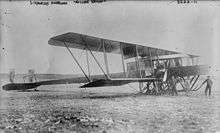Sikorsky Russky Vityaz
| Russky Vityaz | |
|---|---|
.jpg) | |
| The definitive Russky Vityaz version with four tractor configuration engines. | |
| Role | Airliner |
| Manufacturer | Russian Baltic Railroad Car Works |
| Designer | Igor Sikorsky |
| First flight | 10 May 1913 |
| Number built | 1 |
|
| |

The Sikorsky Russky Vityaz (Russian: Русский витязь), or Russian Knight, previously known as the Bolshoi Baltisky (Russian: Большой Балтийский) (The Great Baltic) in its first four-engined version,[1] was the first four-engine aircraft in the world, designed by Igor Sikorsky and built at the Russian Baltic Railroad Car Works (Russo-Baltiiskyi Vagonnyi Zavod or R-BVZ) in Saint Petersburg in early 1913.
Development
Sikorsky conceived the S-21 design in 1911, when no known aircraft could lift more than 600 kilograms (1,300 lb). The carrying capacity record belonged to the French pilot Ducis, who had flown 800 m (2,600 ft) with a load of 600 kg (1,323 lb). On hearing about the construction of the Russky Vityaz in the early spring of 1913, the experts and the media around the world were predicting a complete failure. However, the first aerial test of the Russky Vityaz on 10 May 1913 was successful. At the time, many people in other parts of the world considered it to be a newspaper hoax, and did not believe it. Observers believed that an aircraft of such dimensions would never leave the ground.
Design
The Russky Vityaz was a four-engine multi-bay biplane with unequal-span wings. The dual-spar wings had a rectangular planform and a chord of 2.5 m (8 ft 2 in). The distance between the wings (wing gap) was also 2.5 m (8 ft 2 in). Its fuselage was a rectangular section girder, covered with plywood sheets. The aircraft had a cabin with a dual control column, two passenger cabins and a storage room for spare parts. There was also an open deck forward of the pilot's cabin equipped with a searchlight and machine gun. The ailerons on the upper wings provided for the airplane’s stability. The first quadruple-engined version of what was to become known as the Russky Vityaz, when it was known as the Bolshoi Baltisky, was powered by four engines installed in tandem pairs (it was originally designed as a twin-engine plane, known as "Le Grand").[2] The Russky Vityaz moved the twin pusher engines from the Bolshoi Baltisky's layout onto the leading edge of the lower wing as tractor configuration powerplants, outboard of the original inner tractor configuration engines.
Operational history
After the Russky Vityaz's first test flights between 10 and 27 May 1913 (Old Style dates), it was established that a passenger could even walk around the cabins without causing any problems to stability.[3] The aircraft left the ground after a 700-meter (2,300 ft) takeoff run.
Sikorsky’s aspirations for the Russky Vityaz proved to be short-lived. While parked on the runway on 23 June 1913, the aircraft was crushed by an engine that fell off a single-seat Morane aircraft during a landing.[4] Sikorsky decided not to repair the seriously damaged Russky Vityaz and began working on his next brainchild — the Ilya Muromets.
Specifications (Russky Vityaz)
Data from [5]
General characteristics
- Crew: three
- Capacity: up to seven passengers
- Length: 20 m (65 ft 7 in)
- Upper wingspan: 28 m (91 ft 10 in)
- Lower wingspan: 20 m (65 ft 7 in)
- Height: 4 m (13 ft 1 in)
- Wing area: 120 m2 (1,300 sq ft)
- Empty weight: 2,700 kg (5,952 lb)
- Gross weight: 4,000 kg (8,818 lb)
- Max takeoff weight: 4,940 kg (10,891 lb)
- Powerplant: 4 × Argus As I 4-cylinder water-cooled in-line piston engine, 75 kW (100 hp) each
Performance
- Maximum speed: 90 km/h (56 mph; 49 kn)
- Range: 170 km (106 mi; 92 nmi)
- Service ceiling: 600 m (1,969 ft)
References
| Wikimedia Commons has media related to Sikorsky S-21. |
- ↑ Sergei Sikorsky (2007). The Sikorsky Legacy-Bolshoi Baltisky (1st ed.). Arcadia Publishing. p. 27. ISBN 978-0738549958.
- ↑ Page, Walter Hines; Page, Arthur Wilson (July 1914). "Man And His Machines: A Russian "Airbus"". The World's Work: A History of Our Time. XLIV (2): 360. Retrieved 4 August 2009.
- ↑ "The Sikorsky 'Bus in Russia", Flight, 21 June 1913
- ↑ Swopes, Bryan R. "23 June 1913". This Day in Aviation. Retrieved 26 June 2014.
- ↑ King, H.F. (1969). Milestones of the Air (McGraw-Hill ed.). New York: Jane's All the World's Aircraft Publishing Company. p. 22.